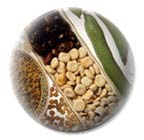- Home
- Introductions

|
Vegetable Seed Production: PrinciplesYou are here: Seed Production: Principles: Mineral Nutrients & Seed Production Mineral Nutrients & Seed Production Mineral deficiencies in seed crops can reduce yield and if the deficiency is severe, reduce seed quality. Soil testing prior to planting is needed to determine how to adequately fertilize a seed crop. There are many factors to consider when determining the type and amount of fertilizer to use and when it should be applied:
Today many vegetable seed farmers practice prescription fertilization. In other words, no materials are applied unless analysis shows that plants need fertilizer. The principle of prescription agriculture is test-apply-test. This principle saves growers money by limiting inputs. It is also environmentally friendly because it helps reduce pollution caused by the excess use of chemicals. Another modern practice is precision placement of fertilizer in the field where it can be best utilized by the plant. For example, for many years farmers broadcast granular fertilizer over the entire field prior to planting. Broadcasting fertilizer is a common practice for field crop production, but may vegetable crops are planted at wide spacing, so much of the broadcast fertilizer is not available to the crop. Furthermore, many vegetable crops are shallow-rooted and cannot recover fertilizer placed between rows. Precision placement of fertilizer in the row near the root zone of the plant reduces fertilization costs, does not stimulate between-row weed growth, and may help reduce fertilizer contamination of run-off water. Therefore row-banding at planting or fertigation (combining irrigation with fertilization) is often used with vegetable seed crops. Vegetable seed crops have nutrient requirements similar to those of crops grown for vegetable production. Where possible, nutrients that stimulate reproductive development can be supplemented with normal fertility regimes, particularly when soil testsw show that these nutrients are limiting. Boron, for example, increases the number of fruiting sites and seed produced per pod in legumes such as pea and bean. Molybdenum also is essential for optimum nitrogen fixation of legume seed crops. Another approach to stimulating reproductive development in vegetable seed crops is to split the application of fertilizers at planting and before flowering. This avoids luxury consumption of the elements at the time of application, improves crop uptake efficiency, and increases the formation of reproductive structures. Generally, lower nitrogen and phosphorus levels are used in seed production because these encourage continued vegetative growth. The importance of Nitrogen With vegetable crops that are harvested for reproductive tissues like broccoli, tomato, or muskmelon, nitrogen stimulates vegetative growth at the expense of reproductive growth. In these crops, excessive N fertilization early in the season may delay or even inhibit flower production and fruit set. Nitrogen status of plant tissue is often discussed in terms of the carbon to N ratio of the plant tissue. The optimum nutrient status for some crops change during the growing season. With tomato, for example, moderately low carbon to N levels early in development are best to stimulate vegetative growth, so the plant develops sufficient size to support fruit development during the reproductive cycle. Just prior to flowering, the carbon to N ratio should increase to promote flowering and fruit set. After fruit set or flower initiation, the carbon to N ratio should ideally fall to stimulate growth of the developing fruit. Coupled with other data and observations, plant tissue analysis is an effective aid in evaluating the actual nutrient status of a crop and is an important part of prescription fertilization (test-apply-test). For example, soil tests might show that a field is properly fertilized while foliar analysis may show that a critical nutrient may be lacking in the tissue. This discrepancy suggests a root disorder that is preventing the nutrient from being removed from the soil. Additional fertilization would be wasteful and would not solve the problem. So despite the additional cost, plant tissue analysis can determine the effectiveness of various fertilizer treatments and show whether the plant is properly fed. Samples taken several times during the season or over several growing seasons may be required to correctly evaluate the nutrient status of a particular soil-plant system. Effects of temperature, moisture, and previous weather conditions can influence the nutrient composition of a plant. The desired concentration of an element should occur within the sufficiency range. The limits for this range vary depending on the crop, the tissue being analyzed, and the stage of growth sampled. Commonly, fully expanded, recently matured leaf samples are used for analysis. Researchers in Florida and California have developed in-field plant tissue analysis techniques. Portable hand-held nitrate and K meters are used to measure the nutrient content of leaf petiole sap that has been expressed using a garlic press or similar device.
Although results may not be as accurate as laboratory results, they give growers a rapid real-time assessment of the mineral nutrient status of a crop. It is best to correct plant nutrient deficiencies before there are visible
symptoms. However, it is often helpful to visually identify nutrient deficiency
symptoms even though nutrients may limit productivity before the deficiency
is apparent. The following is a list of general deficiency symptoms
for the essential elements (except for C, H, O). Soil testing and plant
analysis will confirm infield visual diagnoses.
*Deficiency symptoms for a particular crop may vary widely depending on the crop being investigated. For this reason, the deficiency symptoms that are listed should be used only as a guide.
Next: Tillage
|
||||||||||||||||||||||||||||||||||||